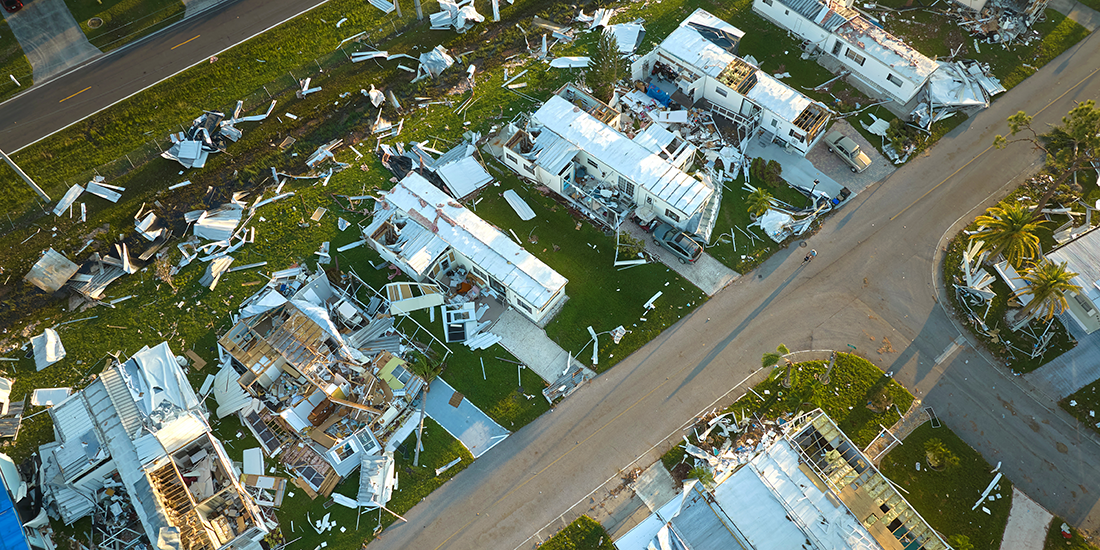Most recently published

The Use of Naval Militias in Homeland Defense
Brent Bankus
September 21, 2005
Only four states – Alaska, New Jersey, New York, and Ohio – now have active naval militias. But two more states, California and Wisconsin, are now considering reorganization initiatives, and many other states may want to consider the low-cost/high-value

The Other Gulf War
Martin D. Masiuk
September 21, 2005
DomPrep’s publisher discusses the impact of Hurricane Katrina, several changes and upgrades in the IMR Goup’ domestic-preparedness publications, and the company’s roadmap to an even more productive future.

Thomas Carr, Jr. Chief, Montgomery County (MD) Fire & Rescue Service
John F. Morton
September 21, 2005
Carr’s report on his department’s assistance to the states of Louisiana and Mississippi, with special focus on the unprecedented calamities the beset the so-called “City That Care Forgot.”

Public Health at the End of the World
Joseph Cahill
September 7, 2005
The nation’s public-health professionals played a major support role during and immediately after Katrina hit land – and will continue to do so long after most other first responders have gone home.

Kurt J. Nagle, President & CEO of the American Association of Port Authorities
John F. Morton
September 7, 2005
His association’s views on what is needed to meet Coast Guard/MTSA requirements, and the case for more Port Security Grant funding.

Words and Bullets: Al Qaeda’s Textbook for Terror
Neil C. Livingstone
September 7, 2005
An alarming discovery in Manchester, England, gives Western intelligence and counterterrorism agencies a Muslim insider’s view of what it takes to fight a Holy War against the United States and its allies.

Maritime FSOs: The New Breed of Homeland-Security Professionals
Laurie Thomas
August 24, 2005
The duties of the nation’s new facility security officers are many and daunting, but also vitally important both to national security and to the U.S. economic well-being.

CBRNE Attacks at Sea: Time to Revisit the Maritime SAR International
Ashley Moore
August 24, 2005
The next terrorist attacks might be against the U.S. system of ports and waterways, where the nation is most vulnerable.

Justin Thomas Russell, Director for Port Security, Center for Security & Operations, AnteonCorporation
John F. Morton
August 24, 2005
His views on, among other important subjects, the need to balance security policies and programs against “the unfettered flow of commerce.”

The Coast Guard’s Post 9/11 Deepwater Program: An Enduring Solution for U.S. Maritime Security
Gordon I. Peterson
August 24, 2005
USCG lives up to its Semper Paratus tradition in formulating plans for the multimission service’s “fleet of the future.”

USAWC’s New Emphasis on Homeland Security
Brent Bankus
August 10, 2005
One of the world’s most-renowned naval/military educational institutions revamps its curriculum to incorporate courses and research projects related to the global war on international terrorism.

Agitated Delirium: A Primer for EMS/Law-Enforcement Personnel
Jay Kehoe
August 10, 2005
The sudden death of anyone is a personal tragedy for his/her friends and next of kin – and creates a sometimes extremely complicated issue for police, EMS, and correctional personnel to deal with.

Roger Cressey, President, Good Harbor Consulting
John F. Morton
October 5, 2005
The former White House advisor discusses the hurricane recovery and response operations, the implications for a DHS reorganization–and for the possible use of the military to cope with future disasters–and the role of the private sector.

The Use of Naval Militias in Homeland Defense
Brent Bankus
September 21, 2005
Only four states – Alaska, New Jersey, New York, and Ohio – now have active naval militias. But two more states, California and Wisconsin, are now considering reorganization initiatives, and many other states may want to consider the low-cost/high-value

The Other Gulf War
Martin D. Masiuk
September 21, 2005
DomPrep’s publisher discusses the impact of Hurricane Katrina, several changes and upgrades in the IMR Goup’ domestic-preparedness publications, and the company’s roadmap to an even more productive future.

Thomas Carr, Jr. Chief, Montgomery County (MD) Fire & Rescue Service
John F. Morton
September 21, 2005
Carr’s report on his department’s assistance to the states of Louisiana and Mississippi, with special focus on the unprecedented calamities the beset the so-called “City That Care Forgot.”

Public Health at the End of the World
Joseph Cahill
September 7, 2005
The nation’s public-health professionals played a major support role during and immediately after Katrina hit land – and will continue to do so long after most other first responders have gone home.

Kurt J. Nagle, President & CEO of the American Association of Port Authorities
John F. Morton
September 7, 2005
His association’s views on what is needed to meet Coast Guard/MTSA requirements, and the case for more Port Security Grant funding.

Words and Bullets: Al Qaeda’s Textbook for Terror
Neil C. Livingstone
September 7, 2005
An alarming discovery in Manchester, England, gives Western intelligence and counterterrorism agencies a Muslim insider’s view of what it takes to fight a Holy War against the United States and its allies.

Maritime FSOs: The New Breed of Homeland-Security Professionals
Laurie Thomas
August 24, 2005
The duties of the nation’s new facility security officers are many and daunting, but also vitally important both to national security and to the U.S. economic well-being.

CBRNE Attacks at Sea: Time to Revisit the Maritime SAR International
Ashley Moore
August 24, 2005
The next terrorist attacks might be against the U.S. system of ports and waterways, where the nation is most vulnerable.

Justin Thomas Russell, Director for Port Security, Center for Security & Operations, AnteonCorporation
John F. Morton
August 24, 2005
His views on, among other important subjects, the need to balance security policies and programs against “the unfettered flow of commerce.”

The Coast Guard’s Post 9/11 Deepwater Program: An Enduring Solution for U.S. Maritime Security
Gordon I. Peterson
August 24, 2005
USCG lives up to its Semper Paratus tradition in formulating plans for the multimission service’s “fleet of the future.”

USAWC’s New Emphasis on Homeland Security
Brent Bankus
August 10, 2005
One of the world’s most-renowned naval/military educational institutions revamps its curriculum to incorporate courses and research projects related to the global war on international terrorism.
Vayl Oxford, Acting Director of the DHS Domestic Nuclear Detection
Vayl S. Oxford and John F. Morton
August 10, 2005
His views on the office’s mission, interfaces with other agencies, and the future development of a global nuclear-detection architecture.
Piracy 2005: A New and Major Terrorism Concern
Laurie Thomas
July 27, 2005
Although romanticized in the movies, piracy remains a clear and present danger in many areas of the world – and, in the Age of Terrorism, poses a major new threat to the United States and its Free World allies.
Dennis R. Schrader, Director of Maryland’s Office of Homeland Security
John F. Morton
July 27, 2005
Mr. Schrader discusses all-hazards preparedness, intel fusion centers, use of GIS, and more. Schrader also comments on Maryland’s regional all-hazard approach, which already is developing horizontal linkages with adjacent states.
Mid-Term Report Card, A Note from the Publisher
Martin D. Masiuk
July 27, 2005
The Publisher offers a mid-term report and asks readers to grade the first semester’s effort.
Lessons Learned: A Major Educational Resource
Laurie Thomas
July 13, 2005
In the middle of an Area Maritime Security Committee meeting, a facility security officer wonders out loud why it is so difficult to coordinate and disseminate information about terrorist activities, particularly in the maritime field, between all of the government agencies and private-sector entities that have a legitimate “need to
New York, Madrid, London: What City Is Next?
Joseph Cahill
July 13, 2005
The latest Great Awakening terrorist strikes should serve not only as another warning but also as a spur to collective action, particularly by the nation’s first-responder communities.
Governor James S. Gilmore, III, A Focus on Border Protection, Medical Surge Capacity
John F. Morton
July 13, 2005
Former Virginia Governor James S. Gilmore III shares his views, as chairman of the bipartisan Congressional Commission appointed to assess U.S. domestic-response capabilities, on such major issues as vulnerability assessments, risk management, border prot
Homeland Defense Begins at Home!
James D. Hessman
July 13, 2005
The Department of Homeland Defense and American Red Cross are leading the way, but true national preparedness requires an all-hands effort starting with teachers and students, parents, first responders, businessmen and factory workers, the media and the m
Electro-Muscular Disruption Technology and How it Works
Jay Kehoe
June 29, 2005
Shockingly enough, Tasers are becoming the most humane working tool available to law-enforcement personnel and correctional officers who have no choice but to use force in dealing with aggressive and/or demented individuals who are threatening the peace
Ludwig Benner: The Father of Modern HAZMAT Thinking?
Rob Schnepp
June 29, 2005
In the late 1960’s, far too many firefighters were dying in the line of duty when the fires were fighting involved hazardous materials. One man, Ludwig Benner, realized that changes were needed, both in the way firefighters were being trained and in the
Virginia, North Carolina, and Wisconsin
Anthony Lanzillotti
June 15, 2005
Virginia Develops free emergency resources for businesses, but imposes security fees on incoming oceanborne cargoA new online resource – the Virginia Business Emergency Survival Toolkit (available at www.vaemergency.com/business) – has been developed by a group of emergency organizations in Virginia that includes information and other resources that the state’s businesses can use
Asymmetric Warfare: Redefining Standard Terms
Ashley Moore
June 14, 2005
Chaos and confusion reign not just on the battlefield but also, particularly in recent times, in policy pronouncements, position papers, and the public consciousness. Principal problem is a proliferation of acronyms meaning almost the same thing – but not
Follow Us
Get Instant Access
Subscribe today to Domestic Preparedness and get real-world insights for safer communities.


